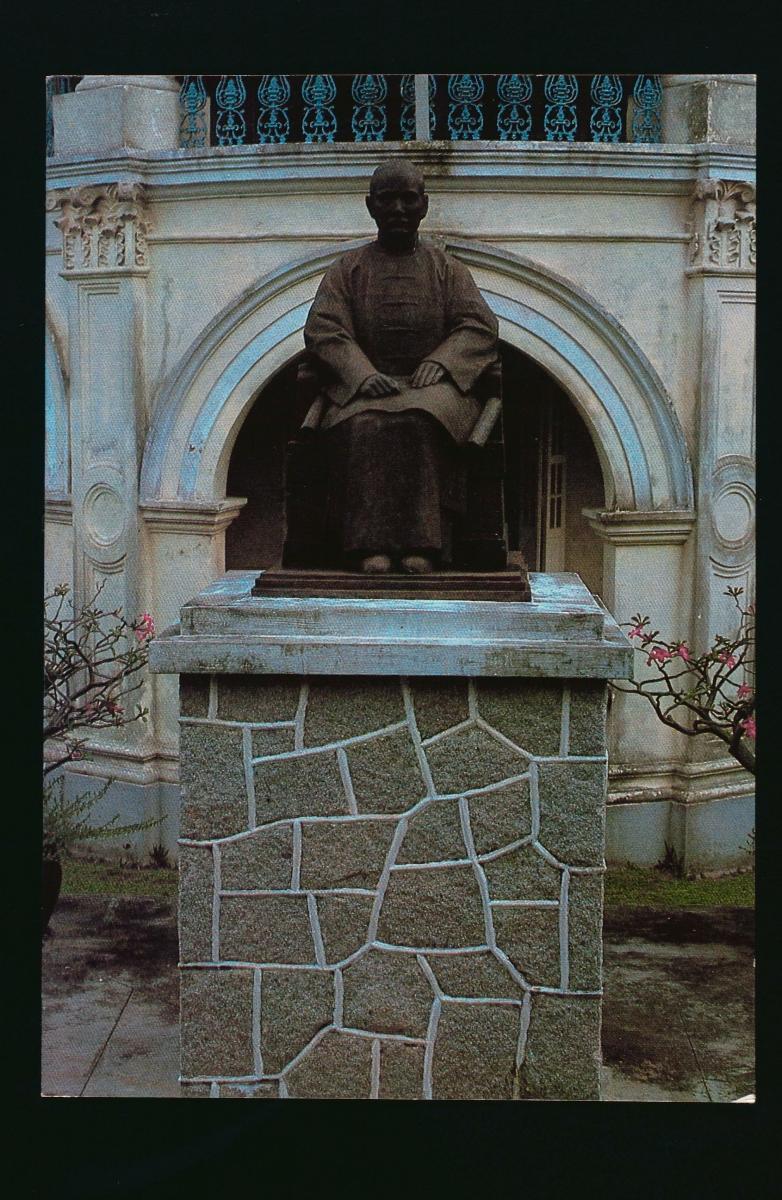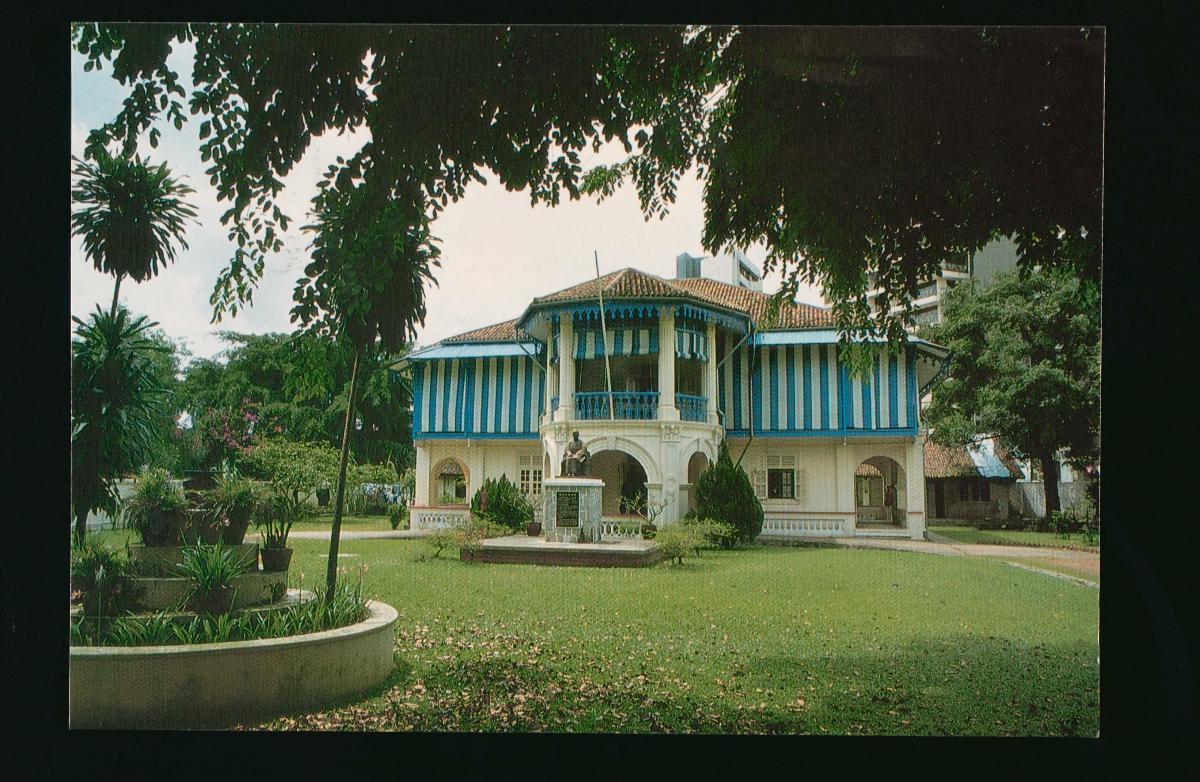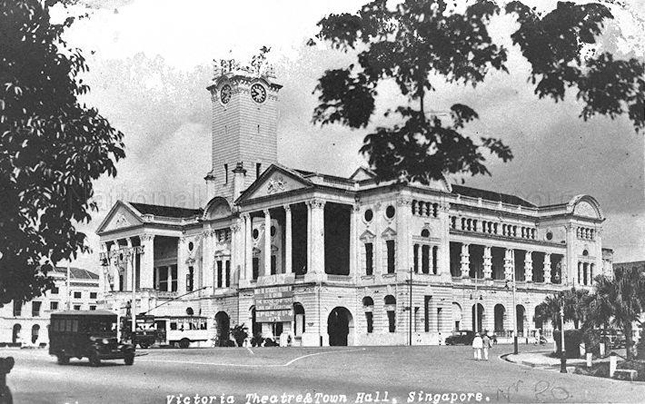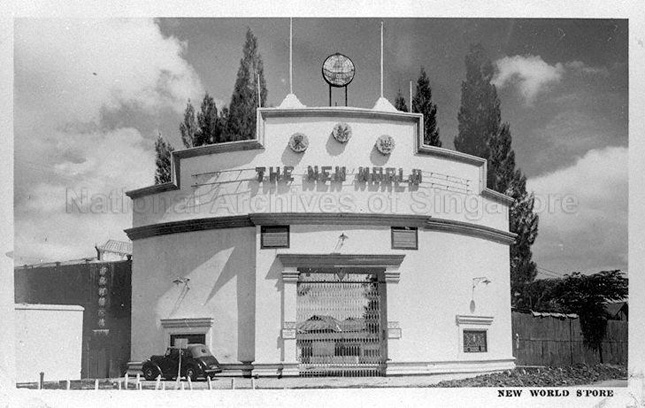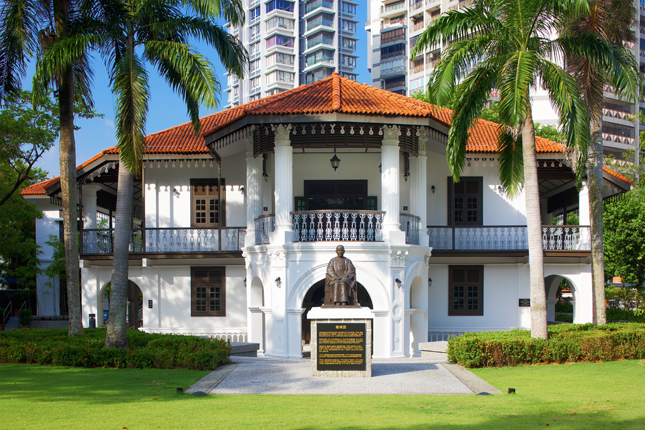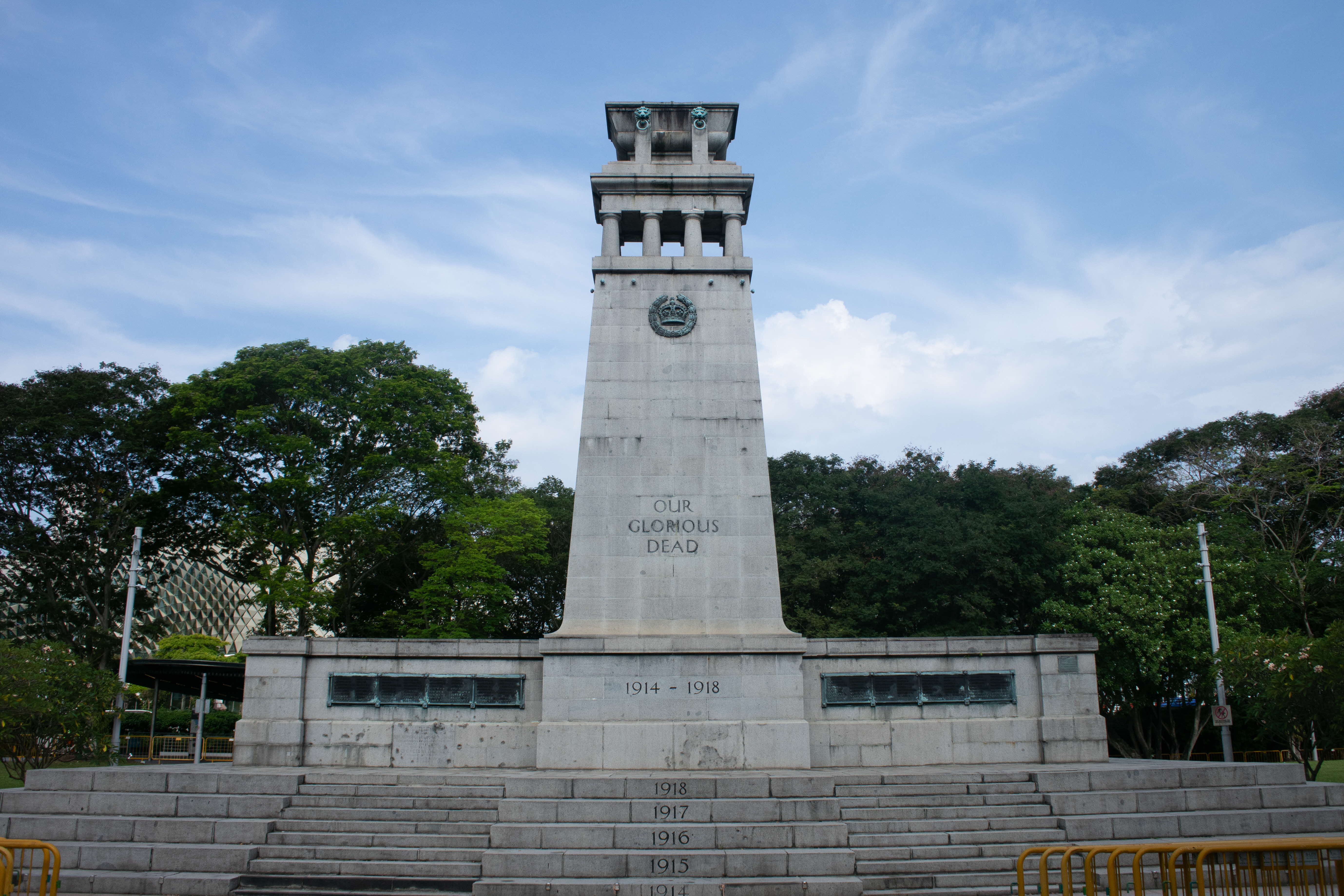Located within the Balestier precinct, Sun Yat Sen Nanyang Memorial Hall (also known as Wan Qing Yuan, 晚晴园) is one of the few surviving examples of villas that were once common in colonial Singapore. Formerly known as Sun Yat Sen Villa, it was gazetted as a National Monument in 1994 for the crucial role it played in the 1911 Chinese Revolution, by serving as Dr. Sun Yat Sen's revolutionary base in Nanyang (Southeast Asia) at the beginning of the 20th century.
In 1900, the wealthy Chinese merchant Boey Chuan Poh commissioned the construction of a two-storey villa. Completed by 1902, the residence was named “Bin Chan House” (明珍庐) after Boey’s racehorse, Bin Chan.
The villa features a compact, symmetrical layout with open verandahs at the front and sides. The upper floor comprises three bedrooms opening to a central hall, with a projecting verandah serving as an open sitting room. Another bedroom was located on the ground floor, along with a dining room and bathroom. A covered walkway connected the main building to an annex building at the back, which housed the kitchen, servants’ quarters, stable, and coach house. In the late 1900s, the annex building and walkway were demolished to make way for an extension of the building as a memorial hall.
Like many villas built during the late 19th and early 20th century, Bin Chan House was located within a landscaped garden. The villa was thoughtfully designed for tropical living, featuring movable louvre windows to provide ample natural lighting and ventilation.
The building façade features Corinthian columns, continuous storey-defining cornices, ornate arched windows and doors, as well as articulated roof eaves. Wealthy Chinese merchants often incorporated western architectural elements into their residences to convey refinement, status, and wealth. A projecting, curved porte-cochère (a porch for receiving guests from horse carriages) adds a touch of grandeur to the entrance.
In September 1902, Boey sold the villa to timber merchant Lim Ah Siang. In 1905, Teo Eng Hock and his brother, Teo Bah Tan (both maternal uncles of prominent pioneer Lim Nee Soon) bought the villa from Lim. The villa was renamed “Wan Qing Yuan” (meaning “serene sunset garden”) with the intention of providing their mother a tranquil retirement setting. The name “Wan Qing” is derived from a line in a poem by Tang Dynasty poet Li Shang Yin, which, when translated to English, means “The heaven shows compassion for the tender grass, just like how we treasure our twilight years” (天意怜幽草,人间重晚晴).
Teo Eng Hock was a critic of the Qing government and co-founded Thoe Lam Jit Poe (图南日报), the first pro-revolutionary Chinese newspaper in Southeast Asia, with his friend Tan Chor Lam. In July 1905, Teo Eng Hock, Tan Chor Lam and Lim Nee Soon had the opportunity to meet Dr. Sun Yat Sen, when the latter visited Singapore on his way to Europe from Japan. Upon Dr. Sun’s return to Singapore later that year, Teo Eng Hock, with his mother’s permission, offered Wan Qing Yuan to be used for Dr. Sun’s revolutionary activities.
Dr. Sun subsequently established the Tong Meng Hui (Chinese Revolutionary Alliance) Singapore Branch at Wan Qing Yuan, using it as a base for propagating and disseminating his revolutionary ideas. In July 1908, Dr. Sun designated Singapore as the alliance’s headquarters in Nanyang to better coordinate revolutionary efforts in the region.
Group photograph of Dr. Sun Yat Sen (seated centre), Teo Eng Hock (seated second from left), Tan Chor Lam (seated third from left), Lim Nee Soon (seated first from right), and other members of the Tong Meng Hui Singapore Branch at Wan Qing Yuan (late 1905). The arch of the porte-cochère is visible in the background. Collection of the National Museum of Singapore, National Heritage Board. Gift of Mr and Mrs Lee Kip Lee.
During this period, Wan Qing Yuan served as an important nerve centre from which Dr. Sun oversaw fundraising activities and directed revolutionary activities in Southeast Asia. It was also a gathering place for notable figures of modern China such as Hu Han Min, Wang Jing Wei, Huang Xing and Ju Zheng, as well as revolutionaries from Southeast Asia. Dr. Sun Yat Sen himself stayed at Wan Qing Yuan on four occasions between 1905 and 1909.
Following Teo Eng Hock’s sale of Wan Qing Yuan in August 1910, the villa changed hands several times. In 1937, six Chinese leaders from the Singapore Chinese Chamber of Commerce—Lee Kong Chian, Tan Ean Kiam, Lee Chin Tian, Chew Hean Swee, Lee Choon Seng and Yeo Kiat Tiow—pooled their resources to purchase the building, which was then in a dilapidated state. These businessmen then donated the villa to the Singapore Chinese Chamber of Commerce a year later in 1938.
Photograph of six Chinese community leaders at Wan Qing Yuan (1937). Courtesy of Sun Yat Sen Nanyang Memorial Hall.
Funded by the Chinese Nationalist government, the villa was renovated and refurbished as a memorial hall to Dr. Sun Yat Sen. The hall displayed artefacts related to Dr. Sun, collected from overseas Chinese communities in Southeast Asia and was opened to the public on New Year’s Day in 1940.
When the Japanese occupied Singapore from 1942 to 1945, they used Wan Qing Yuan as a communications base, resulting in the destruction of many of the original artefacts and furniture in the memorial hall. After the end of the Second World War, the Nationalist government provided funds to refurbish Wan Qing Yuan, and the Singapore branch of the Chinese Nationalist Party (Kuomintang) was set up in the villa.
Following the establishment of the People’s Republic of China (PRC) in October 1949, the British government in Singapore dissolved the Kuomintang branch at Wan Qing Yuan. Consequently, Wan Qing Yuan was returned to the Singapore Chinese Chamber of Commerce (SCCC) in 1951. Following renovations in 1964, it was renamed Sun Yat Sen Villa.
In 1994, the Singapore government gazetted the Sun Yat Sen Villa as a national monument. Two years later, the Singapore Chinese Chamber of Commerce, by then known as the Singapore Chinese Chamber of Commerce & Industry (SCCCI), renamed the villa “Sun Yat Sen Nanyang Memorial Hall” and unveiled plans for its expansion. Following closure for renovations, the memorial hall was reopened to the public in 2001.
There stand two magnificent bronze murals along the periphery wall of the grounds of the memorial hall. The longer mural, funded by the Lee Foundation and completed in 2005, is titled “Our Common Memories”. It portrays the multi-racial and multi-cultural lives and heritage of the people of Singapore, from the arrival of the British to the outbreak of World War II. The second mural focuses on the preparations for World War II and the Sook Ching, a period during which large numbers of Chinese men were rounded up and executed.
“Our Common Memories” Bronze Mural (2016). Courtesy of Sun Yat Sen Nanyang Memorial Hall.
In 2009, the Singapore Chinese Chamber of Commerce and Industry signed a memorandum of understanding with the National Heritage Board for the latter to manage Sun Yat Sen Nanyang Memorial Hall. The memorial hall underwent further redevelopment in October 2010, with the new storyline tracing Dr. Sun’s revolutionary activities in Southeast Asia and highlighting Singapore’s contributions to the 1911 Revolution. On 8 October 2011, Sun Yat Sen Nanyang Memorial Hall was reopened to the public to commemorate the centenary of the 1911 Revolution.
Entrance to the permanent galleries at the Memorial Hall (2016). Courtesy of Sun Yat Sen Nanyang Memorial Hall.
The memorial hall comprises four permanent galleries, showcasing important artefacts and hosting special exhibitions that raise awareness of Singapore’s role in and contributions to the 1911 Revolution, while also fostering an appreciation of Chinese culture. After more than a decade, the memorial hall will close from 16 September 2024 till 2027 for restoration of the building and a revamp of the galleries. During its closure, the memorial hall will continue to run off-site engagement programmes such as travelling exhibitions, festivals, and joint programmes with partners.
3D Model of Wan Qing Yan














